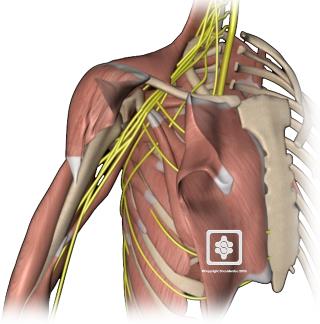Shoulder Anatomy

BONES
Humerus
The upper arm bone.
Scapula
The shoulder blade.
Glenoid
The end of the scapula that forms a joint with the humerus.
Clavicle
The collarbone, which connects the shoulder to the sternum.
Acromion
The roof of the shoulder that is formed by the scapula.
Coracoid Process
The thick hook-like bony protrusion attached to the front of the scapula.
ARTICULAR CARTILAGE
The rubbery, slippery substance that covers the ends of bones at the joint. Healthy cartilage enables smooth joint movement and absorbs shock. In the shoulder, articular cartilage covers the end of the humerus and lines the socket of the glenoid.

JOINTS
Glenohumeral Joint
The loose ball-and-socket joint at the shoulder where the humerus articulates with the glenoid region of the scapula.
Acromioclavicular Joint
The joint where the clavicle articulates—or joins—with the acromion.
Sternoclavicular Joint
The joint where the clavicle and sternum meet, connecting the arms and shoulders to the main skeleton.
Scapulothoracic Joint
The so-called “false joint” where the scapula passes over the ribcage. Rather than having ligament attachments like true joints, it is held in place by bones, bursae and muscles.

LIGAMENTS AND TENDONS
Labrum
The lip-like cartilage that encircles the edge of the glenoid, enabling it to provide a deeper cup for the glenohumeral joint. Also the site of attachment between the biceps tendon and the glenoid.
Joint Capsule
The fibrous sac surrounding the glenohumeral joint formed by ligaments.
Proximal Biceps Tendon
The tendon that attaches the biceps muscle of the upper arm to the shoulder’s glenoid, becoming part of the labrum.
Proximal Triceps Tendon
The tendon that attaches the triceps muscle of the upper arm to the scapula below the glenoid.
Rotator Cuff Tendons
Four tendons that connect the supraspinatus, infraspinatus, teres minor and subscapularis shoulder muscles to the humerus.
MUSCLES
Rotator Cuff Muscles
The supraspinatus, infraspinatus, teres minor and subscapularis muscles that enable the shoulder to rotate within the ball-and-socket joint a full 360 degrees.
Deltoid
The strongest muscle located on the outer layer of shoulder that enables the arm to be lifted away from the side.
Biceps
The muscle originating at the shoulder and running down the front of the upper arm that serves to stabilize the humerus in the glenohumeral socket and contributes to elbow flexion.
Triceps
The muscle originating at the shoulder and running down the back of the upper arm that is primarily responsible for elbow extension.
NERVES
Axillary Nerve
The axillary nerve originates from the posterior cord of the brachial plexus. It passes through the quadrilateral space under the teres minor, which it innervates, before sending branches to the deltoid muscle and the lateral skin of the shoulder.
Radial Nerve
One of three nerves originating at the shoulder that carry signals from the skin and joints to the brain and back again to the muscles of the upper extremities to coordinate movement and position sense. The radial nerve begins from the inside of the upper arm, travels diagonally across to the outer elbow and then again crosses to the thumb side of the forearm and into the back of the thumb, index and half of the middle finger. Muscles controlled by the Radial Nerve include the triceps and wrist and finger extensors.
Median Nerve
One of three nerves originating at the shoulder that carry signals from the skin and joints to the brain and back again to the muscles of the upper extremities to coordinate movement and position sense. The median nerve begins from the outside of the upper arm and travels down the inner side of the upper arm before moving to the center of the forearm and into the palmar side of the thumb, index, middle and half of the ring finger and distal segment of the thumb, index, middle and ring fingers. Muscles controlled by the Median Nerve include the wrist and finger flexors.
Ulnar Nerve
One of three nerves originating at the shoulder that carry signals from the skin and joints to the brain and back again to the muscles of the upper extremities to coordinate movement and position sense. The ulnar nerve begins from the inside of the upper arm and travels down the inside of the forearm and into the palmar and dorsal sides of the pinky and half of the ring finger. Muscles controlled by the Ulnar Nerve include the wrist and finger flexors, as well as the small muscles in the hand that coordinate fine movements.
BLOOD VESSELS
Axillary Artery
The main artery that brings oxygenated blood into the axilla (armpit) and upper arm before becoming the brachial artery.
BURSAE
Sacs containing lubricating fluid that serve to reduce friction between tendons and bones and skin and bones.



